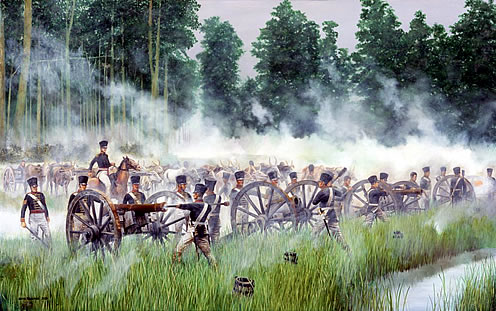| |
« Click on Picture to
Return » |
|
|
 |
|
The Bengal Artillery in action, Arakan, Burma 1825
During the 1st Burma War, the Governor-General of India sent a force by sea to Rangoon, which battled its way up-river to Ava, the Burmese capital.
Another force, 11,000 strong, commanded by Brigadier General Morrison, set off from Chittagong on 1st February 1825 to advance overland towards Myohaung, the capital of Arakan.
7th Company, 2nd Battalion of the Bengal Artillery (formed in 1802) was part of this force. Continually having to cross tidal creeks and the swampy, overgrown jungle between them, it was a most difficult march for the troops. A field battery in those days was customarily equipped with light 12-pounder and light 6-pounder guns, and light 5.5 inch howitzers, drawn by bullocks. The British and Indian troops fought their way against the Burmese troops for nearly two months, the artillery bombarding the enemy’s strong stockades, made of heavy teak logs, which defended the pass leading to Myohaung. These strong defensive positions were overcome one by one.
On 27th March the Burmese position was at Mahatti, ten miles south of Myohaung, around a pagoda on a hill surrounded on three sides by a chaung, fordable only at low water; the banks were steep and the hill itself was stockaded. After the fog cleared in the morning, three companies of HM 44th Foot drove in the enemy’s troops on the near bank, and after a preliminary artillery bombardment the river was crossed when the tide ebbed. The hill of Mahatti was at once occupied. On 29th March, the British launched their attack on the main Burmese garrison at Myohaung, and after a few days of fighting the Burmese were finally defeated on 1st April 1825.
Medium: Oil on Canvas
Printed image size(s): B2 only (58 x 38 cm)
Owner: 88 (Arracan) Battery Royal Artillery
Price(s):
|
|
| |
|
|
|
|
|
|
|
|
|
|
|
|
|
|
|
|











